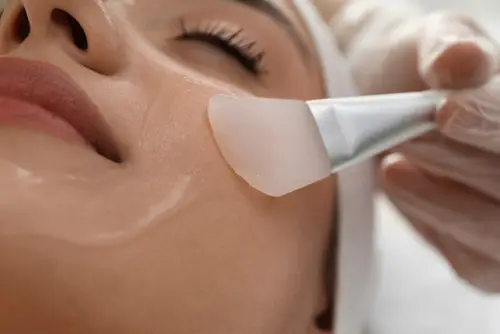Chemical Peels for Skin improvement
The Transformative Power of Chemical Peels
Procedure Summary
Chemical peels are a standout skincare treatment, offering deep exfoliation to rejuvenate and revitalize the skin. Suitable for addressing a variety of concerns like aging signs, sun damage, acne scars, and uneven skin tone, chemical peels are a versatile solution for those seeking enhanced skin health and appearance.

Understanding Chemical Peels:
A chemical peel involves applying a chemical solution to the skin, causing it to exfoliate and eventually peel off. This process reveals a newer, smoother, more refined skin layer. Depending on specific skin concerns and goals, chemical peels can range in intensity from light to deep.
Benefits of Chemical Peels:
- Improved Skin Texture: Smooths rough skin and reduces the appearance of scars.
- Acne and Oil Control: Effectively manages acne and reduces oiliness.
- Reduced Signs of Aging: Minimizes fine lines and wrinkles for a youthful appearance.
- Corrected Sun Damage: Repairs and reduces visible sun damage effects.
- Even Skin Tone: Addresses hyperpigmentation, freckles, and uneven tone.
Types of Chemical Peels:
- Light Peels: Use mild acids like alpha-hydroxy acid (AHA) for gentle exfoliation, ideal for mild skin issues and minimal downtime.
- Medium Peels: Employ trichloroacetic acid (TCA) for deeper exfoliation, suitable for deeper wrinkles, acne scars, and uneven tone.
- Deep Peels: Use phenol for intensive treatment of serious skin issues, with more significant downtime.
Cost and Downtime:
The cost of chemical peels varies depending on the type of peel and the geographical location of the clinic. Light peels may be more affordable and require minimal downtime, often with patients returning to regular activities immediately. Medium and deep peels are typically more costly and involve longer recovery periods, with deep peels requiring extensive downtime for healing.
The Chemical Peel Process:
- Consultation: Assessing to determine the right peel type and discuss outcomes.
- Preparation: Skin cleansing followed by chemical solution application.
- Peeling Phase: Exfoliation of the skin, neutralization, and removal of the solution.
- Recovery: Post-peel care includes skin hydration and sun avoidance, with recovery time depending on the peel’s intensity.
Chemical peels offer a powerful way to improve various skin concerns, making them an invaluable component of any skincare regimen. They promote skin renewal and rejuvenation, leading to a healthier, more radiant complexion. It’s crucial to consult a skincare professional for the right peel type for your skin and to understand the associated costs and expected downtime for the best results.
